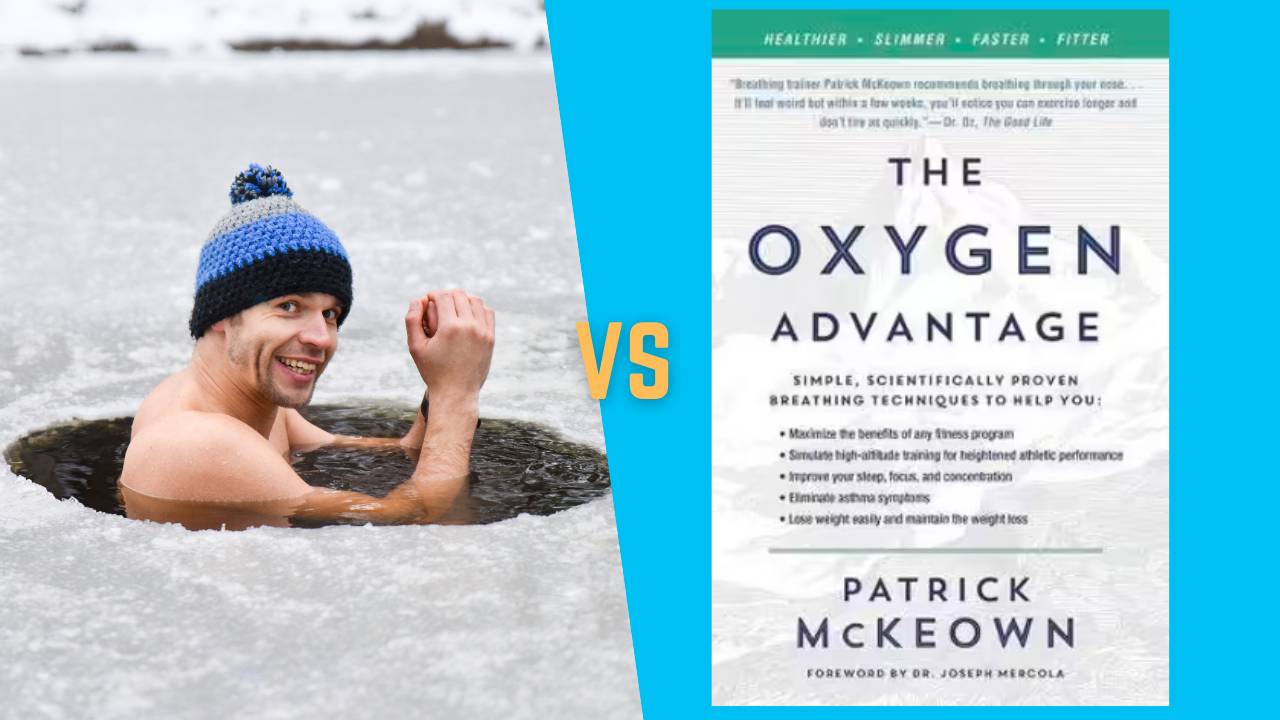Wim Hof Breathing Techniques vs Oxygen Advantage

Wim Hof Breathing Techniques vs Oxygen Advantage
Wim Hof’s breathing techniques and the Oxygen Advantage are two different approaches to improving respiratory health and managing stress and anxiety through specific breathing techniques.
Also known as the Wim Hof Method, it is a system developed by Dutch extreme athlete Wim Hof. It involves a combination of cold exposure, breathing exercises, and mindset training. Hof claims that the method can improve mental and physical health and enhance the immune system.
A study conducted in 2014 on Wim Hof and a team that he had trained found that they could activate the stress response using his powerful technique, which mitigates the effects that an endotoxin E coli would usually have on the body. Instead of causing an inflammatory response, the Wim Hof breathing techniques increased the number of anti-inflammatory markers, and no symptoms were present.
The Wim Hof Method involves three main components: cold exposure, breathing exercises, and mindset training. Cold exposure involves gradually acclimating the body to cold temperatures through cold showers, ice baths, and winter swimming. This is believed to improve circulation, reduce inflammation, and boost the immune system.
The breathing exercises in the Wim Hof Method involve taking rapid, deep breaths in succession, followed by a long exhale. This is intended to cause alkalosis in the body and stimulate the sympathetic nervous system, which is responsible for the “fight or flight” response.
The mindset training component of the Wim Hof Method involves cultivating a positive attitude and developing mental resilience. This is achieved through meditation, visualization, and goal setting.
Oxygen Advantage
On the other hand, the Oxygen Advantage is a program developed by Patrick McKeown, a specialist in breathing and sleep disorders. It involves a series of exercises designed to improve oxygen utilization, increase lung capacity, and reduce the risk of respiratory problems such as asthma and sleep apnea.
One of the main principles of the Oxygen Advantage is that modern humans have become over-reliant on mouth breathing, which can lead to various health issues. Mouth breathing allows air to bypass the nose and enter directly into the lungs, avoiding the natural filtration and humidification process in the nasal passages. This can lead to dryness in the airways, making them more susceptible to irritation and infection.
The Oxygen Advantage program aims to encourage nasal breathing and teach individuals how to optimize their breathing patterns to get the most out of their lungs. By retraining the body to breathe through the nose and use the diaphragm more effectively, it is claimed that individuals can increase their oxygen uptake and reduce the risk of respiratory problems.
One of the essential exercises in the Oxygen Advantage program is the “Butterfly Breath,” which involves sitting with the feet together and hands on the knees and then taking slow, deep breaths through the nose while pressing the tongue against the roof of the mouth. This helps to encourage nasal breathing and activate the diaphragm, which is the primary muscle responsible for breathing.
Another critical aspect of the Oxygen Advantage program is the use of nasal breathing as a tool to manage stress and anxiety. When stressed or anxious, our breathing tends to become shallow and rapid, which can lead to a decrease in oxygen levels in the body. By learning to control our breath and breathe through the nose, it is claimed that we can regulate our stress and anxiety levels and improve our overall sense of well-being.
So, what are the main differences between Wim Hof’s breathing and the Oxygen Advantage?
The main difference is that the Wim Hof Method involves a combination of cold exposure, breathing exercises, and mindset training. At the same time, the Oxygen Advantage focuses primarily on breathing exercises and nasal breathing to improve respiratory health and manage stress and anxiety.
Both approaches have received mixed reviews, with some claiming that they have significantly improved their respiratory health and others finding little or no benefit. It is worth noting that neither program is a substitute for medical treatment and should not be used. It is essential to consult if you have a respiratory problem or are concerned about your breathing.
How to Perform Wim Hof Breathing Techniques
If you’re interested in learning how to perform Wim Hof breathing, the first step is understanding the basic breathing technique. Here’s how to do it:
1. Find a comfortable seated position with your back straight and your feet planted firmly on the ground.
2. Take 30 deep breaths in rapid succession, inhaling through your nose and exhaling through your mouth.
3. On the final exhale, hold your breath for as long as you comfortably can.
4. Take a deep breath in and exhale fully.
5. Hold your breath again for as long as you comfortably can.
6. Take a deep breath in and exhale fully.
It’s important to remember that the Wim Hof Method is not a one-size-fits-all approach, and you should always listen to your body and adjust the intensity of the breathing exercises as needed. It’s also important to start slowly and gradually work your way up to longer and more intense sessions.
How to develop nasal breathing for Oxygen Advantage
Nasal breathing is the act of inhaling and exhaling air through the nose. It is the natural and most efficient way for the body to breathe, as the nose is designed to filter, humidify, and warm the air we inhale. In contrast, mouth breathing bypasses these natural processes and can lead to dryness in the airways, making them more susceptible to irritation and infection.
Improving nasal breathing can have several benefits, including improved respiratory health, better sleep, and reduced stress and anxiety. If you’re interested in improving your nasal breathing, here are a few tips to get you started:
1. Practice nasal breathing during physical activity: Nasal breathing is more efficient than mouth breathing, so it can help improve endurance and performance during physical activity. Try practising nasal breathing during your workouts or other physical activities.
2. Use nasal dilators: Nasal dilators are small devices you can place inside your nostrils to help keep them open and improve airflow. They can be accommodating if you have a naturally narrow nasal passage or suffer from nasal congestion.
3. Try nasal irrigation: Nasal irrigation involves using a saline solution to flush out mucus and other irritants from the nasal passages. This can help improve airflow and reduce congestion.
4. Avoid mouth breathing: Try to breathe through your nose rather than your mouth as much as possible. This can take some practice, but it can help improve your nasal breathing and overall respiratory health.
It’s important to note that improving nasal breathing is a process, and it may take time and practice to see results.
Therefore, you must consult a healthcare professional for guidance and support if you’re having difficulty improving your nasal breathing or respiratory problem.
Don’t Let Breathing Get In Your Way
Are you ready to take control of your breath and improve your overall well-being? Our breath training coaching services can help you do just that. Our team of certified professionals has helped countless individuals like you learn powerful techniques to optimize their breathing and improve their respiratory health.
PTH personalised coaching programs are tailored to your needs and goals, and Martin is here to support you every step of the way, answering your questions and providing guidance and encouragement.
Don’t let suboptimal breathing hold you back any longer. Instead, take the first step towards a healthier, happier you and purchase our breath training coaching services today. You’ll be amazed at the positive changes you’ll experience. So, don’t wait any longer. Invest in yourself and your well-being by purchasing our breath training coaching services. You deserve it!




